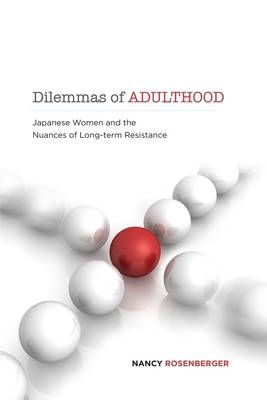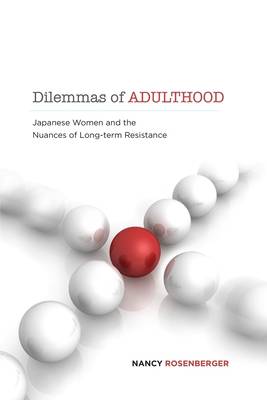
- Retrait gratuit dans votre magasin Club
- 7.000.000 titres dans notre catalogue
- Payer en toute sécurité
- Toujours un magasin près de chez vous
- Retrait gratuit dans votre magasin Club
- 7.000.000 titres dans notre catalogue
- Payer en toute sécurité
- Toujours un magasin près de chez vous
Dilemmas Adulthood
Japanese Women and the Nuances of Long-Term Resistance
Nancy R RosenbergerDescription
In Dilemmas of Adulthood, Nancy Rosenberger investigates the nature of long-term resistance in a longitudinal study of more than fifty Japanese women over two decades. Between 25 and 35 years of age when first interviewed in 1993, the women represent a generation straddling the stable roles of post-war modernity and the risky but exciting possibilities of late modernity. By exploring the challenges they pose to cultural codes, Rosenberger builds a conceptual framework of long-term resistance that undergirds the struggles and successes of modern Japanese women. Her findings resonate with broader anthropological questions about how change happens in our global-local era and suggests a useful model with which to analyze ordinary lives in the late modern world.
Rosenberger's analysis establishes long-term resistance as a vital type of social change in late modernity where the sway of media, global ideas, and friends vies strongly with the influence of family, school, and work. Women are at the nexus of these contradictions, dissatisfied with post-war normative roles in family, work, and leisure and yet--in Japan as elsewhere--committed to a search for self that shifts uneasily between self-actualization and selfishness. The women's rich narratives and conversations recount their ambivalent defiance of social norms and attempts to live diverse lives as acceptable adults. In an epilogue, their experiences are framed by the aftermath of the 2011 earthquake and tsunami, which is already shaping the future of their long-term resistance. Drawing on such theorists as Ortner, Ueno, the Comaroffs, Melucci, and Bourdieu, Rosenberger posits that long-term resistance is a process of tense, irregular, but insistent change that is characteristic of our era, hammered out in the in-between of local and global, past and future, the old virtues of womanhood and the new virtues of self-actualization. Her book is essential for anyone wishing to understand how Japanese women have maneuvered their lives in the economic decline and pushed for individuation in the 1990s and 2000s.Spécifications
Parties prenantes
- Auteur(s) :
- Editeur:
Contenu
- Nombre de pages :
- 234
- Langue:
- Anglais
Caractéristiques
- EAN:
- 9780824836962
- Date de parution :
- 31-10-13
- Format:
- Livre relié
- Format numérique:
- Genaaid
- Dimensions :
- 156 mm x 234 mm
- Poids :
- 498 g







